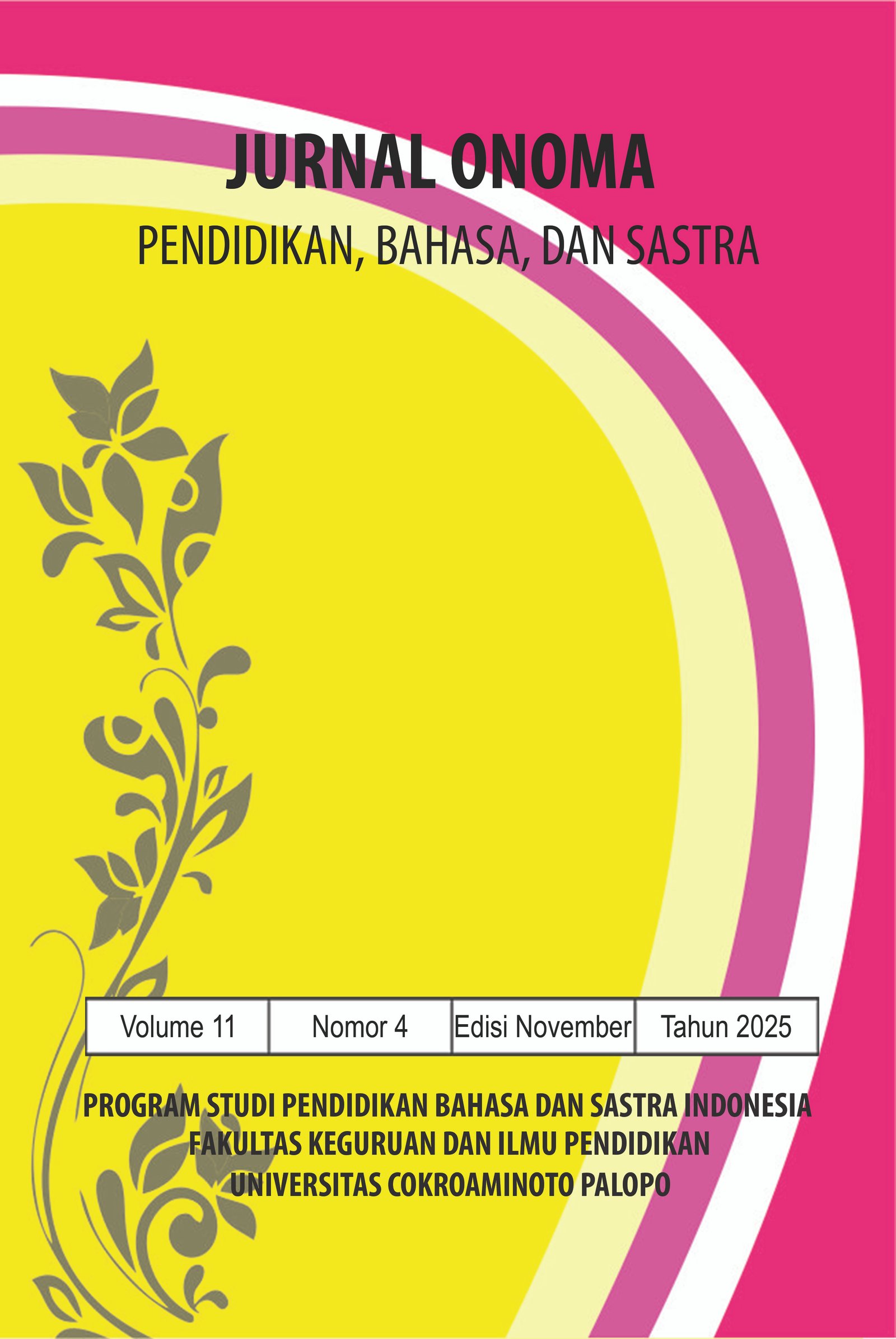Tindak Tutur Ekspresif dalam Interaksi Remaja di Desa Sibado
https://doi.org/10.30605/onoma.v11i4.7136
Keywords:
tindak tutur, tindak tutur ekspresif, bentuk, fungsiAbstract
Penelitian ini bertujuan untuk mendeskripsikan bentuk dan fungsi tindak tutur ekspresif dalam interaksi remaja di Desa Sibado. Penelitian ini menggunakan kajian pragmatik menggunakan metode deskriptif kualitatif dengan teknik pengumpulan data dilakukan berupa teknik simak bebas libat cakap, rekam, dan catat terhadap data lisan. Hasil penelitian ini menunjukan bahwa tindak tutur ekspresif remaja di Desa Sibado meliputi lima bentuk dan fungsi utama: (1) mengucapkan terima kasih, (2) memberi selamat, (3) meminta maaf, (4) menyalahkan, dan (5) memuji. Bentuk terima kasih dicirikan dengan adanya ucapan terima kasih karena suatu bantuan, bentuk dengan adanya ucapan selamat karena suatu hal yang spesial atau membahagiakan, bentuk meminta maaf karena adanya rasa penyesalan atas kesalahan, bentuk menyalahkan karena adanya sebuah kejadian yang tidak dapat diterima atau membuat kesal, dan bentuk memuji karena adanya sesuatu yang menggagumkan atau penghargaan yang diterima.
Downloads
References
Assidik, G. K., Vinansih, S. T., & Kustanti, E. W. (2023). Tindak Tutur Ekspresif pada Penulisan Utas Mengenai Politik, Ekonomi dan Sosial. Pendidikan, Bahasa Dan Sastra, 9(1), 20. https://e-journal.my.id/onoma DOI: https://doi.org/10.30605/onoma.v9i1.2120
elgar, f. j., mckinnon, b., torsheim, t., schnohr, c. w., mazur, j., cavallo, f., & currie, c. (2016). patterns of socioeconomic inequality in adolescent health differ according to the measure of socioeconomic position. DOI: https://doi.org/10.1007/s11205-015-0994-6
Emily, C., Merz, Cynthia, A., Wiltshire, Kimberly, G., & Noble. (2018). Socioeconomic Inequality and the Developing Brain: Spotlight on Language and Executive Function. https://doi.org/https://doi.org/10.1111/cdep.12305 DOI: https://doi.org/10.1111/cdep.12305
Giska. (2023). Tindak Tutur Ekspresif Dalam Percakapan Nonformal Di Kalangan Remaja Di Desa Pelawa Baru.
Mahsun. (2017). Metode penelitian bahasa Tahapan, Strategi, Metode, dan Tekniknya. PT Raja Grafindo Persada. www.rajagrafindo.co.id
Rahmadhani, F. F., & Utomo, A. P. Y. (2020). Analisis Tindak Tutur Ekspresif Dalam Novel Hujan Bulan Juni Karya Sapardi Djoko Damono. Bahtera Indonesia; Jurnal Penelitian Bahasa Dan Sastra Indonesia, 5(2), 88–96. https://doi.org/10.31943/bi.v5i2.69 DOI: https://doi.org/10.31943/bi.v5i2.69
searle, john R. (1972). Speech Act An Essay in The Philosophy of Language. Cambridge: Cambridge University Press.
Searle, J. R. (1979). Expression and meaning: Studies in the theory of speech acts. Cambridge: Cambridge University Press. https://doi.org/10.1017/CBO9780511609213 DOI: https://doi.org/10.1017/CBO9780511609213
Wulandari, W., & Asrianti, A. (2025). Pola Bahasa Generasi Z di Lingkungan Universitas Tadulako. Lingua Franca: Jurnal Bahasa, Sastra, dan Pengajarannya, 9(2), 71-79. https://doi.org/10.30651/lf.v9i2.26623 DOI: https://doi.org/10.30651/lf.v9i2.26623
Wahyunianto, D., Djatmika, & Purnanto, D. (2020). The Use of Speech Act as Communication Strategy of Children with Autism. 3rd International Conference on Language, Literature, Culture, and Education (ICOLLITE 2019), 324–328. DOI: https://doi.org/10.2991/assehr.k.200325.105
Downloads
Published
How to Cite
Issue
Section
Categories
License
Copyright (c) 2025 Cindy Afitasari, Ulinsa Ulinsa, Arum Pujining Tyas, Yunidar Yunidar, Asrianti

This work is licensed under a Creative Commons Attribution 4.0 International License.
In submitting the manuscript to the journal, the authors certify that:
- They are authorized by their co-authors to enter into these arrangements.
- The work described has not been formally published before, except in the form of an abstract or as part of a published lecture, review, thesis, or overlay journal.
- That it is not under consideration for publication elsewhere,
- That its publication has been approved by all the author(s) and by the responsible authorities – tacitly or explicitly – of the institutes where the work has been carried out.
- They secure the right to reproduce any material that has already been published or copyrighted elsewhere.
- They agree to the following license and copyright agreement.
License and Copyright Agreement
Authors who publish with Onoma Journal: Education, Languages??, and Literature agree to the following terms:
- Authors retain copyright and grant the journal right of first publication with the work simultaneously licensed under Creative Commons Attribution License (CC BY 4.0) that allows others to share the work with an acknowledgment of the work's authorship and initial publication in this journal.
- Authors are able to enter into separate, additional contractual arrangements for the non-exclusive distribution of the journal's published version of the work (e.g., post it to an institutional repository or publish it in a book), with an acknowledgment of its initial publication in this journal.
- Authors are permitted and encouraged to post their work online (e.g., in institutional repositories or on their website) prior to and during the submission process, as it can lead to productive exchanges, as well as earlier and greater citation of published work.

















